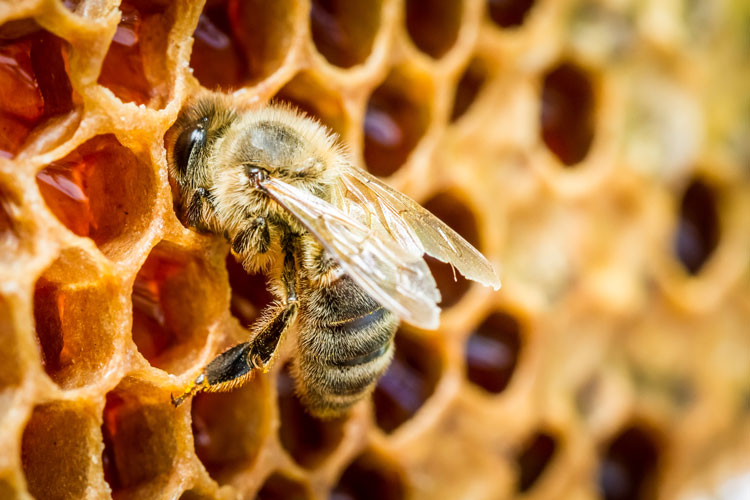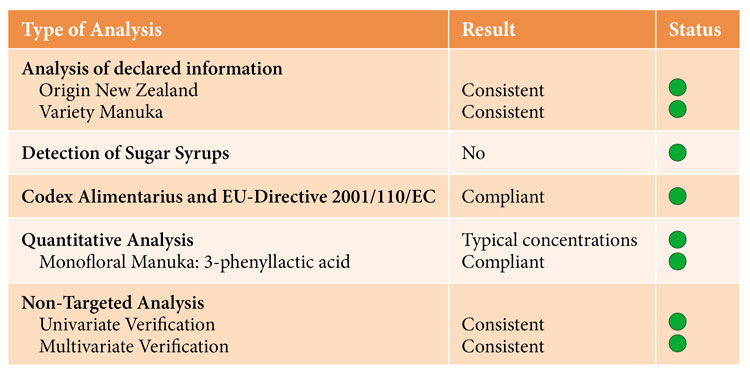The bee’s knees in the fight against honey adulteration
- Like
- Digg
- Del
- Tumblr
- VKontakte
- Buffer
- Love This
- Odnoklassniki
- Meneame
- Blogger
- Amazon
- Yahoo Mail
- Gmail
- AOL
- Newsvine
- HackerNews
- Evernote
- MySpace
- Mail.ru
- Viadeo
- Line
- Comments
- Yummly
- SMS
- Viber
- Telegram
- Subscribe
- Skype
- Facebook Messenger
- Kakao
- LiveJournal
- Yammer
- Edgar
- Fintel
- Mix
- Instapaper
- Copy Link
Posted: 5 November 2020 | Dr Peter Awram | 1 comment
Bee expert, Dr Peter Awram, outlines the benefits of magnetic resonance testing in the fight against honey fraud.


The international honey industry is facing a crisis. The emergence of large quantities of adulterated honey is driving prices down through an abundance of cheap, so-called ‘honeys’. A study conducted by the Canadian Government in 20191 found almost a quarter of commercial honey brands had been adulterated. Illicit products are eroding market prices and consumer trust, while causing significant damage to the beekeeping industry.
The Canadian study was the first instance where a Government used magnetic resonance (MR) testing of honey to prevent the sale of adulterated products, although packers and retailers in Europe have been using the technology to discover fraud for a few years. MR is the first of a new generation of testing methods; while it can detect and measure a number of relevant compounds, it also uses a database of 18,000+ honey samples for comparison. The database, which is continually growing, contains the unique ‘fingerprint’ of thousands of authentic and fraudulent honey samples from across the globe. It can detect matches and abnormalities in minutes.
Keeping up with honey fraud presents a huge challenge to the industry. Advances in analytical technologies like MR spectroscopy are enabling testing laboratories to identify multiple illicit modes of adulteration and production quickly and reliably. This is a necessity in a field where fraud has gone unchecked for so long.
The international honey industry is facing a crisis. The emergence of large quantities of adulterated honey is driving prices down through an abundance of cheap, so-called ‘honeys’. A study conducted by the Canadian Government in 20191 found almost a quarter of commercial honey brands had been adulterated. Illicit products are eroding market prices and consumer trust, while causing significant damage to the beekeeping industry.
The Canadian study was the first instance where a Government used magnetic resonance (MR) testing of honey to prevent the sale of adulterated products, although packers and retailers in Europe have been using the technology to discover fraud for a few years. MR is the first of a new generation of testing methods; while it can detect and measure a number of relevant compounds, it also uses a database of 18,000+ honey samples for comparison. The database, which is continually growing, contains the unique ‘fingerprint’ of thousands of authentic and fraudulent honey samples from across the globe. It can detect matches and abnormalities in minutes.
Keeping up with honey fraud presents a huge challenge to the industry. Advances in analytical technologies like MR spectroscopy are enabling testing laboratories to identify multiple illicit modes of adulteration and production quickly and reliably. This is a necessity in a field where fraud has gone unchecked for so long.
Honey fraud: an age-old problem
Honey adulteration is nothing new. In 1889, Dr Harvey Wiley of the US Department of Agriculture testified before congress that honey was the most adulterated food in the country.
It was in the 1970s, when cheap high-fructose corn syrup (HFCS) became widely available,2 that honey fraud really took off. HFCS adulteration has since been augmented with additional new fraudulent processes that can bypass the previous testing methods.
HFCS can, however, be detected using stable ratio isotope analysis (SIRA), which has led to the use of rice starch, undetectable by SIRA. Several targeted methods exist for the detection of sugar syrups based either on the identification of foreign enzymes used to change the starches into sugars (eg, β-fructofuranosidase, foreign amylases), or on specific markers of syrups (eg, SM‐R and TM‐R), but methods of resin filtration can remove traces of these markers.
Adulteration can take many forms
Here are just some of the ways in which honey can be adulterated:
- Addition of cheap syrups such as HFCS and rice syrup to bulk up the product
- Harvesting immature honey: nectar is immediately removed from the hive and is not transformed by bees into authentic, mature honey. This usually involves the dehydration of the extracted immature honey by vacuum dryer, concentrating the sugars and altering the composition of the final product
- Removing residues with resins: using ion-exchange resins to remove or reduce residues such as banned antibiotics or to lighten the honey colour to disguise origin and remove aroma. This method can remove pollen and other constituents of honey
- Masking or mislabelling the origin: pollen is sometimes added to honey to disguise its botanical or geographical origin. Various organisations have laid out rules regarding the standards for honey, including the FAO3 and Apimondia4 (which declare that any change to honey – addition or removal – constitutes adulteration. This includes pollen, enzymes and even water
- Force feeding sugar syrups to bees and then extracting it as honey.
Outdated testing cannot detect modern fraud
There is only one official method recognised for testing honey, AOAC 998.12, also known as SIRA or Elemental Analyzer Isotope Ratio Mass Spectrometry (EA-IRMS). This method is able to detect different carbon isotopes ratios in the sugars. This method will detect amounts of HFCS over seven percent but is ineffective at detecting rice or beet syrup.
A modified version of this test, liquid chromatography (LC)‐IRMS, suffers from a lack of inter-laboratory reproducibility since approaches for data acquisition and processing are non-standardised.5
Several other methods have been developed to detect adulteration – detection of enzymes and of adulterant markers, and pollen analysis, but the scammers have developed methods of evading these tests because they rely on a specific factor that can be added or removed.
Is MR the solution?
MR can identify specific components in honey and, through the substantial ‘fingerprint’ reference database, allows laboratories to detect many compounds including sugars, acids and amino acids in a sample simultaneously. Like a fingerprint, these data uniquely identify the honey for comparison against the database to check for purity, botanical source and country of origin. Atypical profiles can be noted and investigated further. It is this unique ability to spot a mismatch that reveals the power of MR – giving the ability to identify new and unknown methods of fraud because the ‘fingerprint’ is wrong (see Figure 1).


Figure 1: Analysis Report by Honey-Profiling: Summary of results on testing a sample declared as Manuka Honey. The data analysis is performed according to testing method AA-54-03 (DIN EN ISO/IEC 17025:2005 Accreditation Certificate D-PL-19229-01-00).
The high reproducibility that characterises MR allows precise sample matching, ensuring that the variations observed between spectra are real and not due to analytical drift. Once acquired, the data can be re-analysed, applying new algorithms and a larger reference database – even years later.
The honey database currently contains more than 18,000 reference samples, from 50 countries and 100 botanical varieties. It also includes nearly 2,000 adulterated samples to allow matching to known forms of fraud. An updated database and method based on more samples will be released in the course of this year.
A global approach
Authorities around the world are realising the potential of MR in combating honey fraud. The Government of India, for example, will make authentication testing by MR mandatory for all Indian honey destined for export to the US this year.
In the US, details of a new honey authenticity programme have been provided by the US Customs and Border Protection (CBP) to the Senate Appropriations Committee.6 CBP is purchasing MR instrumentation designed for honey testing, to be used in conjunction with well-established protocols to test for fraudulent country of origin claims. It is anticipated that the CBP will work with the FDA to investigate the potential of testing for economically motivated adulteration.
Waking up to the power of MR technology
Hive numbers around the world have been static for many years due to pressure from the global spread of honeybee diseases, as well as monoculture agricultural practices that emphasise plants that are not bee friendly. Yet honey consumption has increased and is projected to exceed 2.8 million tons by 2024.7 The development of technologies for cheaply producing syrups has created an environment that makes adulteration highly profitable, this is illustrated by disproportionate honey exports compared to hive numbers over the last 12-15 years.8
Ron Phipps, president and founder Committee for the Promotion of Honey and Health (CPNA) International, and former member of the National Honey Board, has said: “Those who have consistently disparaged and dismissed the value of NMR testing of honey have been compelled to sing a different song, as Governments have begun to adopt the tests.”9
Methods such as MR, combined with statistical analysis, are allowing labs to get ahead of the fraudsters.
About the author
Dr Peter Awram is a second‐generation beekeeper and the CEO of Worker Bee Honey and Authentic Food Solutions. He earned his PhD in Microbiology from the University of British Columbia. His beekeeping company, which both pollinates and produces honey, is the largest in British Columbia, Canada. His ISO 17025 accredited testing laboratory is dedicated to the analysis of honey using magnetic resonance spectroscopy, which analyses the entire honey sample and is a significant step forward in detecting honey adulteration.
References
- Report: Enhanced honey authenticity surveillance, https://www.inspection. gc.ca/about-cfia/science-and-research/ our-research-and-publications/report/ eng/1557531883418/1557531883647
- Lohumi S, Lee S, Lee H, Cho B. 2015. A review of vibrational spectroscopic techniques for the detection of food authenticity and adulteration. Trends in Food Science & Technology, 46(1), pp.85-98.
- http://www.fao.org/input/download/standards/310/cxs_012e.pdf
- https://www.apimondia.com/docs/ apimondia_statement_on_honey_ fraud_v_2.pdf
- Zábrodská B, Vorlová L. 2014. Adulteration of honey and available methods for detection – a review. Acta Vet. Brno. 83: S85–S102.
- Report on the International Honey Market, Ron Phipps, June 2020
- Marketresearchfuture.com. (2018). Honey Market Size, Share, Trends, Global Industry Analysis, 2023 | MRFR. [online] Available at: https://www.marketresearchfuture.com/reports/ honeymarket-5139
- The Current Situation on the International Honey Market: Norberto
- García (Prof.). Pages 89-94 | Published online: 03 Jul 2018 https://www. tandfonline.com/doi/abs/10.1080/000577 2X.2018.1483814
- Report on the International Honey Market, Ron Phipps, June 2020
Issue
Related topics
Food Fraud, Quality analysis & quality control (QA/QC), Research & development, Spectroscopy, Supply chain, Technology & Innovation










The 2019 report from the Candian Government about the state of honey adulteration in the Canadian market analysed samples using both NMR and Stable Isotope Ratio Analysis (SIRA). The report summarizes the findings as follows:
“Some samples were unsatisfactory for both tests while some were unsatisfactory for only one:
SIRA testing found 8 (out of 15) samples unsatisfactory that were not found by NMR
NMR testing found 34 (out of 44) samples unsatisfactory that were not found by SIRA
These differences were expected, given the abilities and limitations of each technique, and demonstrate the importance of analyzing the results together to assess compliance.”
This demonstrates that NMR in isolation is not a golden bullet for detection of honey adulteration and that it should be part of a mixed portfolio of testing, which must include SIRA. Therefore SIRA is not an “outdated test which cannot detect modern fraud” as alluded to in this article.
https://www.inspection.gc.ca/about-cfia/science-and-research/our-research-and-publications/report/ eng/1557531883418/1557531883647